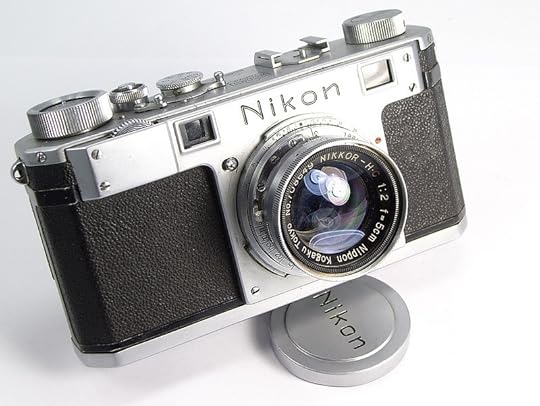Khoi Vinh's Blog, page 139
May 1, 2013
UC.Quarterly
My general skepticism about print-based graphic design products continues, but I have to respect those who keep at it, and manage to turn them into worthwhile objects — and products, even. My friends at Under Consideration, for instance, have just launched UC.Quarterly, a periodical “summary of the most interesting, relevant, and simply fun-to-see projects published each quarter.” The projects are selected from UC’s network of sites about graphic design and branding.
I’ve got the first issue in my hands and it’s a super-fun read. There’s very little additional content beyond the project images themselves, but to me this is the print equivalent of browsing at your leisure through Dribbble or the design-related content on Pinterest. It’s inspiration fodder, basically.
Each issue is published via Newspaper Club, which offers custom, short-run printing on wonderfully casual, unpretentious newsprint. You can buy them for US$15 a pop or subscribe to a year’s worth for US$45. Get yours here.
To follow me on Twitter click here.

April 30, 2013
Fresh music from Steven Jengo Feed Sponsorship

Arrive in the office, make a cup of coffee, open up your email, and turn up your favorite song. We know how it goes.
Check out Steven Jengo’s new single, Summer of 2042.
Fresh tunes with a softly different touch; with that kind of familiar sound, simple and melodic, deep and lazy, freshly brewed for your listening pleasure.
Take care when driving at high volume. Find more at jengo.com.

April 29, 2013
Ghost
Ghost is a Kickstarter project to build a new blogging platform. As the incumbent applications like WordPress have become much broader in scope and therefore more complex than just a tool for publishing content, the Ghost team hopes to create something much more focused on writing, blogging and journalism. Their prototype and their marketing materials look preternaturally professional; if nothing else, I want this project to happen so I can see if it’s as slick as the screen grabs and demo video suggest. On the issue of whether creating the next major blogging platform is an anachronistic ambition or not, I leave it to the market to decide. See the demo and link off to the Kickstarter page at TryGhost.org.
To follow me on Twitter click here.

April 26, 2013
Common Misconceptions about Touch Interfaces
Really superb article on how touch screens really work, and how to design interactions for them. Read here.
To follow me on Twitter click here.

Best Headphones Ever
The best deal I’ve gotten lately is this pair of DJ-style headphones from the unassumingly fantastic technical retailer Monoprice.com, best known for selling incredibly cheap cables of all sorts. I’ve been a customer for years (and if you have any kind of cabling needs, you should be too), but I was surprised to realize lately that they are trying to branch out into more general consumer product categories.
Monoprice is tackling headphones and computer models — and soon high-end audio equipment, car audio, and home automation hardware — with the same pricing strategy that they brought to cables: they “try to make sure that we’re about fifty percent below what a retailer would be selling that product for.” In many cases, they easily clear this bar. The company’s earbud-style headphones, for instance, start at less than US$3 each. The headphones I bought cost just US$21. (Warning, each customer is allowed to buy just ten pairs. Sorry.)
Adding More to Cheap
You can get cheap headphones in just about any dollar store, of course, but Monoprice’s have been widely reviewed as being comparable to headphones in the US$100 and up range. They also sound excellent, as most reviews attest to. In short, they are a ridiculous bargain, but even better, they include an incredibly smart design feature that I haven’t seen before in these DJ-style headphones (admittedly, I’m no audiophile and know very little about the category beyond having owned a few pairs of Sony MDR-V6s): the wire from the headphones is not fixed.

There is a standard, 3.5 mm audio jack at the bottom of the left headphone into which you can plug any standard male-to-male audio cable (including either of the two that ship in the box). This means that should the cable fail — and in these kinds of headphones, it’s the cables that almost always go first — you don’t need to toss them into the trash, open up the earpieces to solder in a new wire, or even pay someone to repair them for you. All you need to do is buy a US$3 replacement cable. Like I said, incredibly smart, and a huge bonus that I would have paid well over US$21 for. Making something for cheap is one thing, but adding great design to it too turns it into an amazing product.
To follow me on Twitter click here.

April 24, 2013
At Home with Facebook Home
I took a so-called “stay-cation” last week to work on the house. I also spent a bit of time playing with Facebook Home on my HTC One X. I was excited to try it, because the prospect of adding a layer of elegance on top of my One X, which is awkward in just about every way, was very appealing.
Facebook Home delivers on that promise, if not completely then at least on a few levels. Installation was painless, and the immediate experience of running what essentially amounts to a Facebook-fueled screen saver on my phone’s home screen is a powerful emotional moment. I found myself getting pulled into Home often, flipping through many more status updates than I normally do on Facebook’s Web site. Its full-screen pictures are truly beautiful; Facebook’s engineers and designers have pulled off some fancy trickery that makes just about every image — and every status update comes with an image — look great.
Thinner, BetterYou might think of Home as a ‘thin’ version of Facebook, a slimmed down counterpart to the full site that has been gracefully translated for handheld devices. In fact, if Facebook were only this — just a simple way to keep up with what my friends are doing, without all the rigamarole of walls and likes and pokes and pages and the endless array of what feels like tedium and busywork — I would like it a lot more.
Neat as it is, this is basically all that Home amounts to, as there’s not much else. Unless you’re an avid user of Facebook chat (I’m not but I guess some people are) Chatheads is a nice implementation of a feature that’s more or less fine but not particularly remarkable. Home’s alternative launch screen is a modest improvement, but not so much so that it represents a clear win over the incumbent launch interface. Similarly, Home’s method of dragging your own picture to access apps (which I found to be consistently and metaphorically confusing) is the kind of detail that Apple or even Google would tend to not even bother announcing.
So even as I praise Facebook Home for being lean, I guess I was expecting a lot more. It’s true that the company never promised that it would be a replacement for Android, so I suppose there’s no justification in lamenting that it’s not. But I had expected Home to open up new vistas on my HTC One X; the reality is that it’s just papering over the view that was already there. Of course, it may very well turn into something more ambitious in time — in fact, I would be surprised if it doesn’t — but for now, as far as breakthrough software goes, I find it to be a really nice screen saver.
A screen saver with some weird glitches, it should be said. Swiping through status updates is buttery smooth, but any time you have to exit the app, the brittleness of imposing a layer on top of Android becomes apparent — the screen blacks out momentarily, or Home fully crashes as often as not, at least in my experience. The interface for unlocking your phone is still the stock Android interface, too, which breaks the spell of Home’s elegance a bit. I also found myself confused by what Home considers secure — even if my phone was ostensibly locked, anyone could pick it up and post a status update at will, without having to get past my PIN screen. It all made me regret my initially optimistic anticipation of the product. Home has a ways to go, yet.
To follow me on Twitter click here.

April 23, 2013
Filepicker.io Cloud Connect APIs Feed Sponsorship

Develop Smarter, Simpler and Better Connected Apps with Javascript
Imagine connecting your app to everything with just 2 lines of code - files from all over the web, across cloud storage source, social networks and devices. Filepicker.io provides a full file system API for your web and mobile applications that allows your app to upload, open, read, write, store, sync and convert files from over 17 sources including Dropbox, Google Docs, Facebook, Skydrive and Box. With the Filepicker.io Javascript API, request a file and receive a simplified URL. Then, upload the URL to your server or serve through your CDN. Filepicker.io includes a customizable drop-in UI widget and an API library allowing you to send uploaded files directly to your S3. Sign up for Filepicker.io today!

April 22, 2013
Nubook
There are many products that purport to solve the problem of Web pages still being fundamentally difficult for just about everyone to create, but Nubook is aimed specifically at so-called creatives — “designers, photographers, architects, artists, actors, stylists, collectors” — who don’t have the skills to code a page or manage a server. In my limited playing around with it, Nubook does in fact seem quite easy, and loaded with exceedingly elegant templates (which is what you’d expect when one of the key folks behind it is Thomas Brodahl). More to the point, the service is focused on presentations, and is not meant to be a traditional host for fully-fledged Web sites or blogs in the traditional sense. That limited focus is a potentially meaningful distinction; I think it’s really smart. Give it a spin at Nubook.com.
To follow me on Twitter click here.

April 16, 2013
PDFpen 6 from Smile Feed Sponsorship

If you need to do anything with PDFs, you need PDFpen. Add a signature, make changes, correct a typo, fill out forms, and more! Got a scanned document? PDFpen includes OCR to convert that scan into text that you can search or edit. Want to remove sensitive info such as tax ID numbers from your PDF? Use PDFpen to redact your private data.
The latest version, PDFpen 6, has improved interface and tools. And now you can export your PDFs to Microsoft® Word format for sharing or editing. See the new features in action in this video by David Sparks.
Buy PDFpen for $60 in the Mac App Store or directly from Smile. Or buy PDFpenPro for $100 and you’ll get advanced features like form creation tools and document permission settings. Download the free demo!

April 12, 2013
Nikon One for Sale
This gorgeous, vintage Nikon One camera is currently on sale at Ebay for US$2,100. If that’s too rich for you, you can still marvel at the gorgeous product shots that the seller has taken of it.
See more pictures, or even just treat yourself and buy it, at the Ebay listing.
To follow me on Twitter click here.

Khoi Vinh's Blog
- Khoi Vinh's profile
- 5 followers









